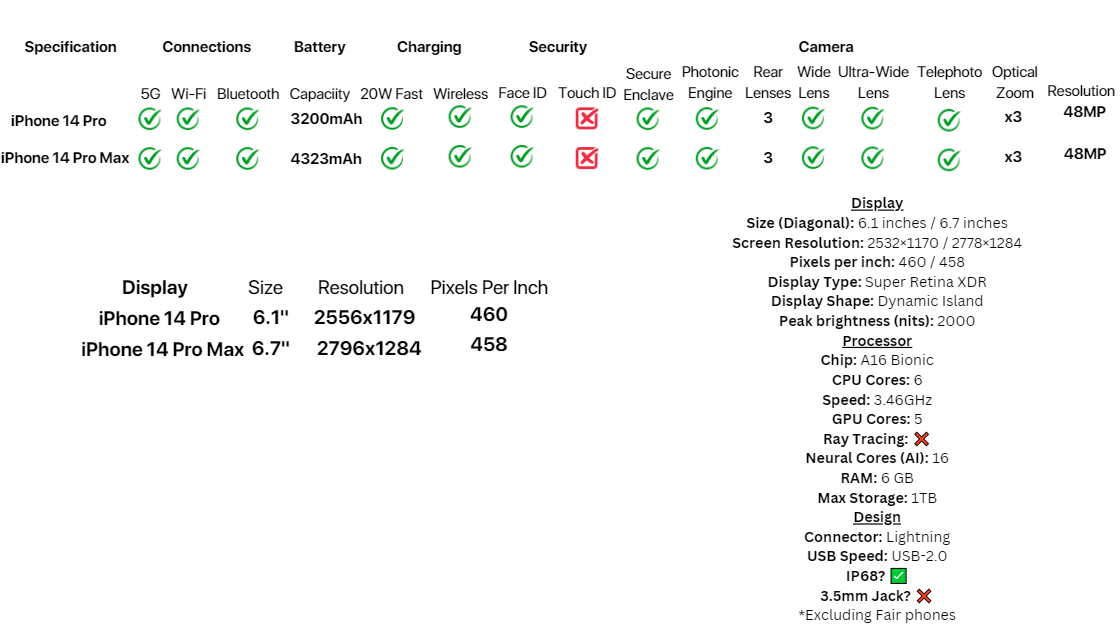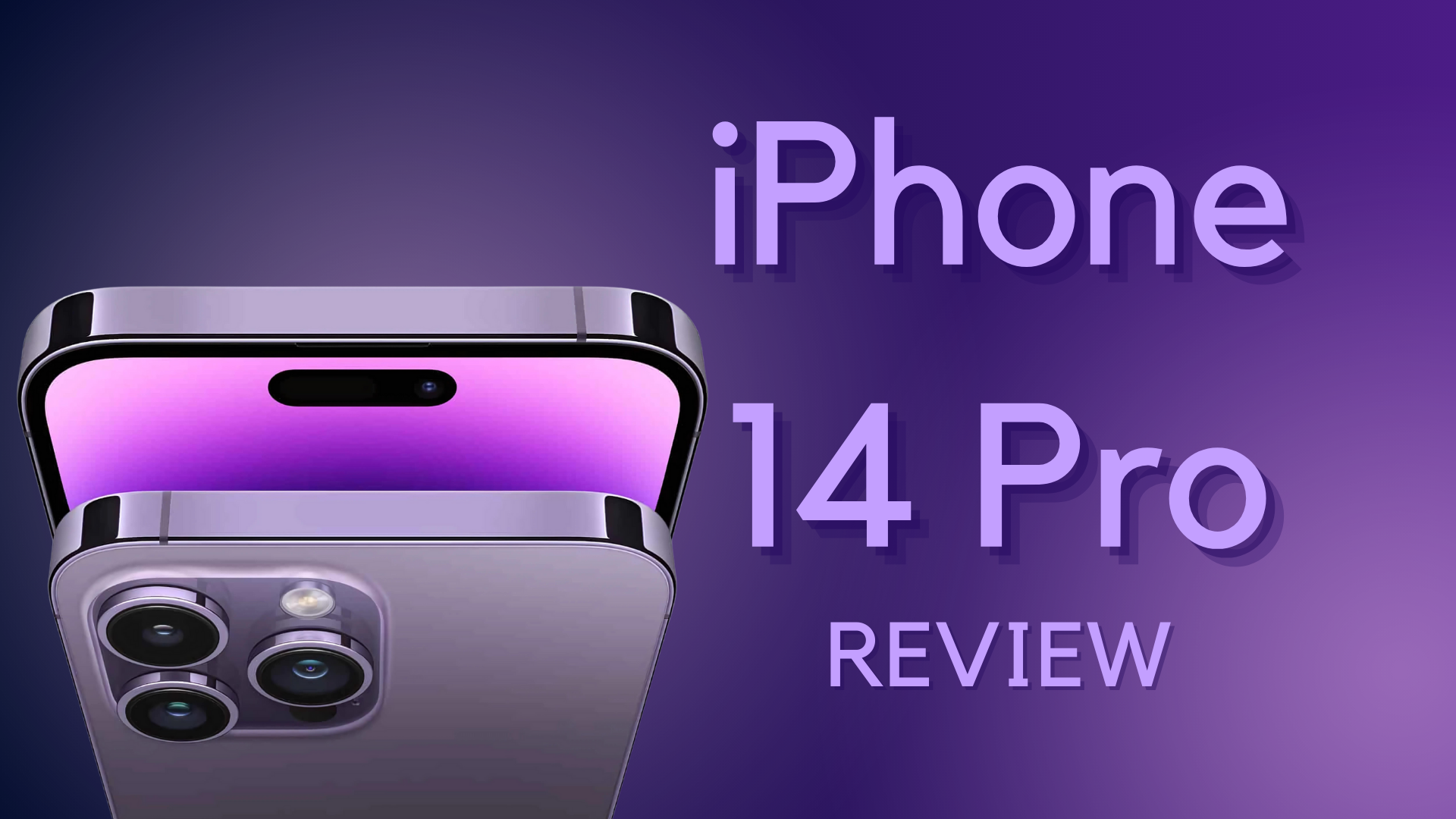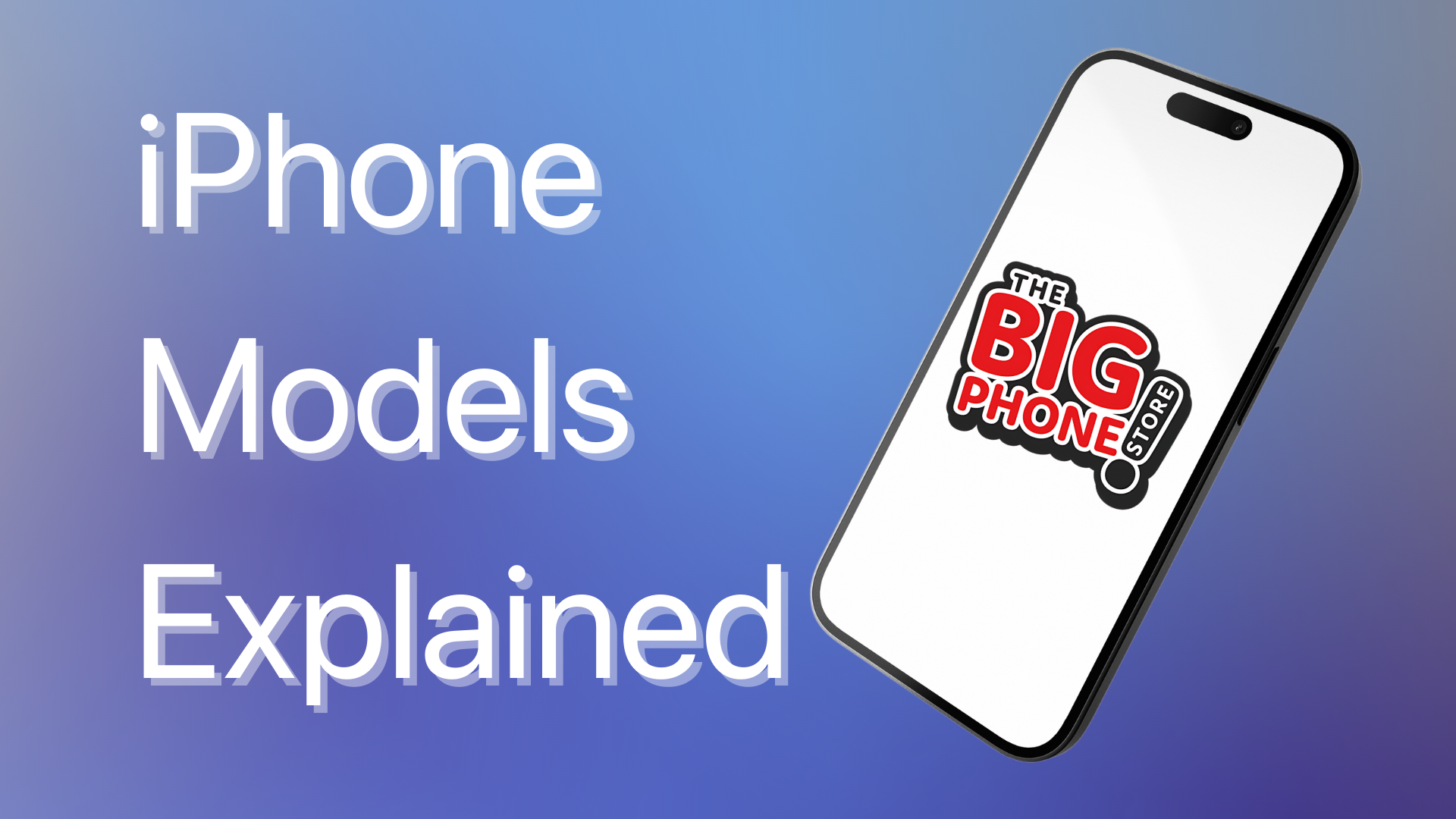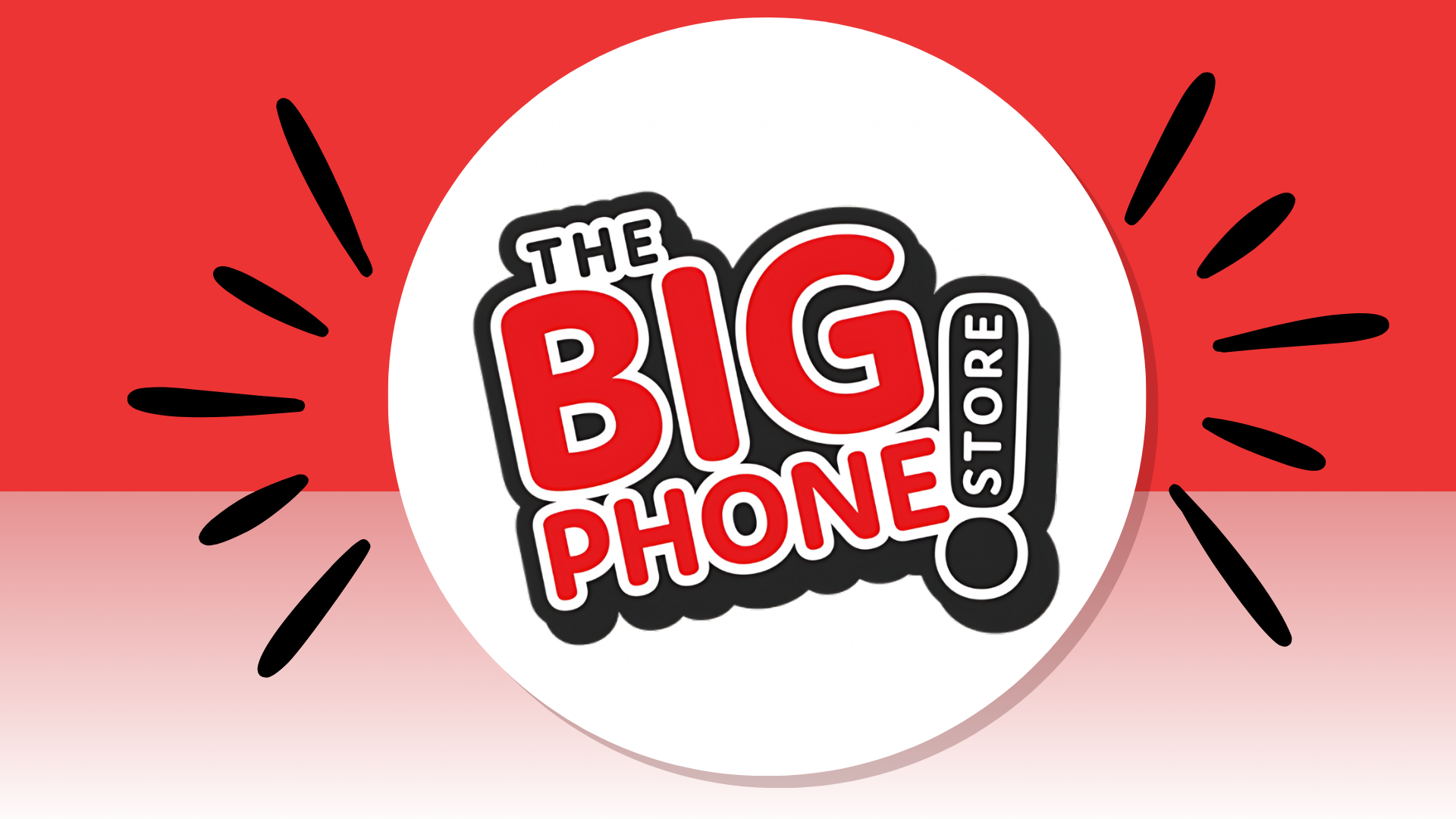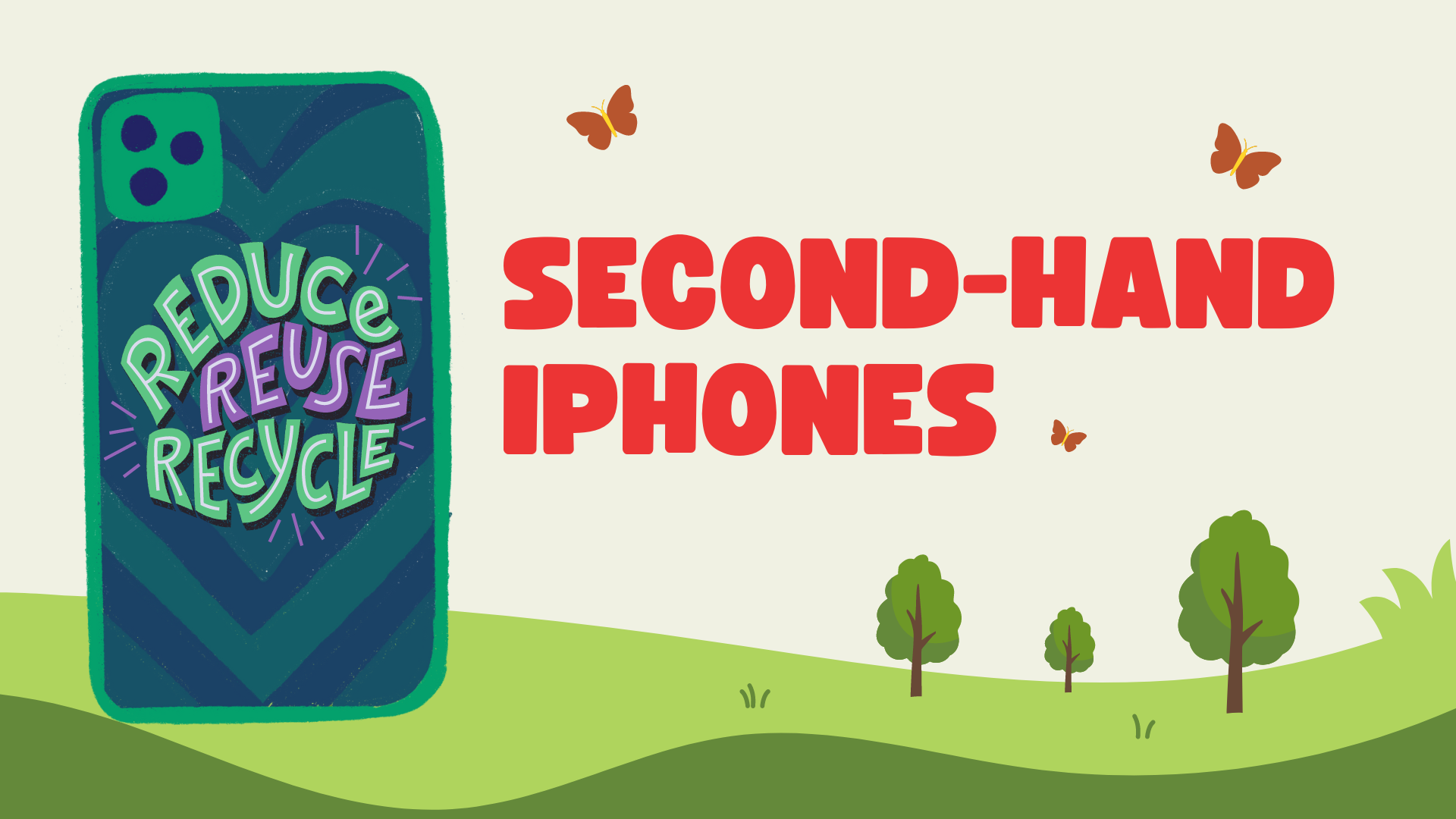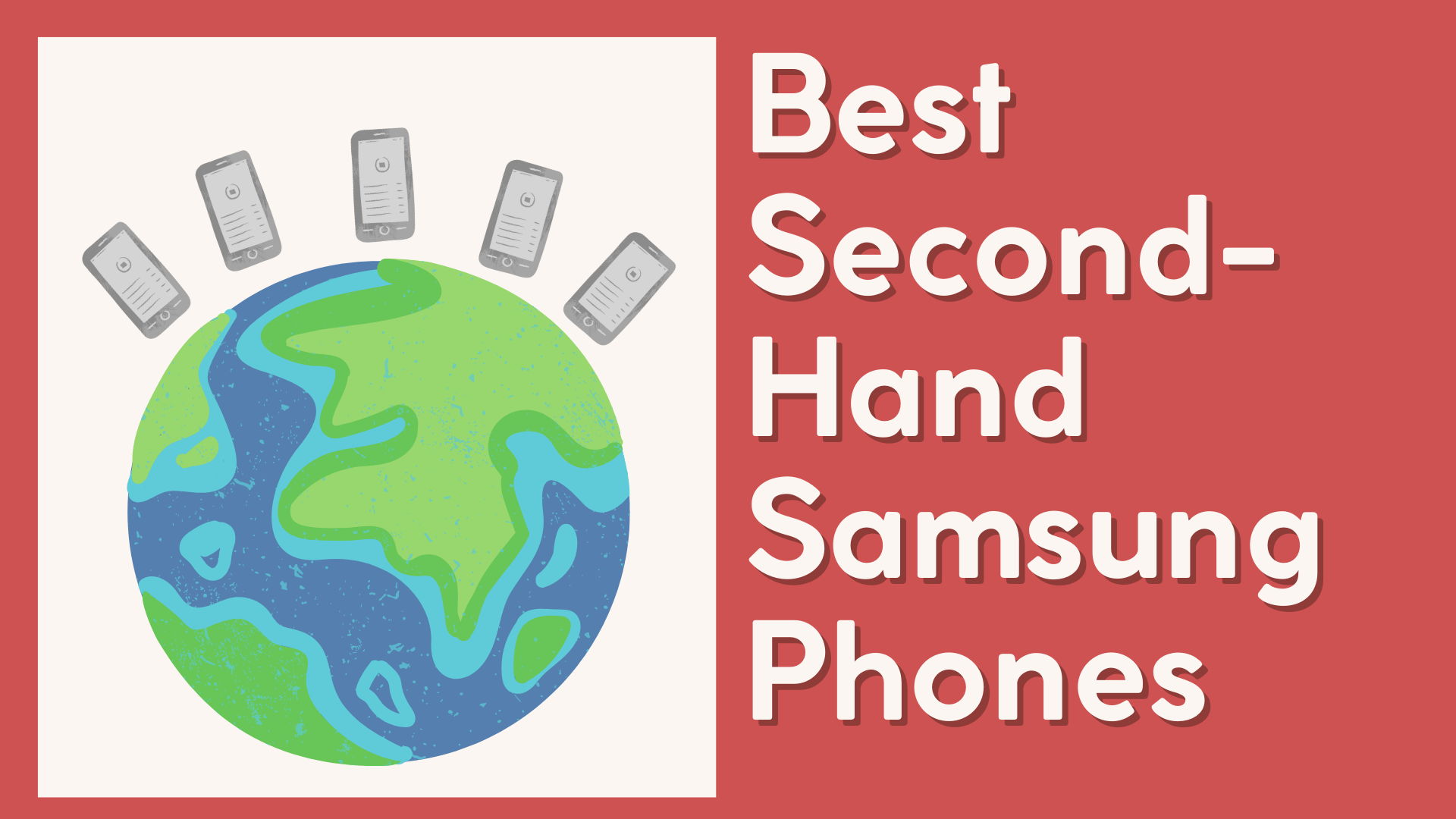Overview:
ToggleApple’s 2022 Pro iPhone has officially been outclassed.
With the arrival of the iPhone 15 Pro, you might be wondering: are the new features compelling enough to justify an upgrade? After putting both models to the test, we’re here to break down what makes the iPhone 14 Pro Max (and its smaller sibling, the iPhone 14 Pro) impressive—but just shy of perfection.
If you’re curious about where the 14 Pro shines and where it falls short, we’ve got you covered with a full comparison of what’s changed and whether the leap to the iPhone 15 Pro is truly worth it.
Pros ✅
The new 48MP main camera delivers stunning photos with greater detail and improved low-light performance, making it a standout feature for photography enthusiasts.
Apple’s innovative replacement for the notch, the Dynamic Island, is an interactive feature that adds functionality by integrating notifications and live activities into the display.
The A16 Bionic chip provides top-tier performance, ensuring smooth multitasking, gaming, and power efficiency, making it one of the fastest chips in any smartphone.
Cons ❌
As with all Pro models, the iPhone 14 Pro comes with a premium price tag, which might not be justifiable for users who don’t need all the high-end features. This is why we suggest buying refurbished where you could get it up to 50% cheaper!
The stainless steel frame and larger battery make it noticeably heavier compared to standard models, which might affect comfort during extended use. But, it certainly feels more durable!
While it does promise all-day usage, the battery life is not significantly better than the iPhone 13 Pro, and some users might find it lacking compared to competing flagship models with larger batteries.
Unique Features
The iPhone 14 Pro was the first iPhone to feature the dynamic island and quad-pixel camera sensors that are now standard on the iPhone 15
This Pro iPhone also comes with the crash detection and satellite SOS features that were launched with the iPhone 14.

Design and Build
We all know iPhones aren’t just about performance—they’re here to turn heads, too. The iPhone 14 Pro sticks with the sleek, muted metallic colours that give the Pro series its signature style. It might look similar to its predecessors and successors, but the Dynamic Island at the top of the display helps it stand out from the iPhone 13 Pro. However, it’s missing the premium titanium build that the iPhone 15 Pro boasts.
Durability-wise, the iPhone 14 Pro doesn’t disappoint. It’s water and dust-proof with the usual IP68 rating and earns extra durability points with its aluminium casing, ready to handle whatever life throws at it.
Price (vs. Storage Size)
In a rare turn of events for Apple, the iPhone 14 Pro and Pro Max were actually more expensive at launch than the current iPhone 15 Pro models.
However, you should always consider how much prices will have changed since the original launch. Even though Apple themselves will never sell discounted iPhones through the Apple store, you can find huge discounts online. If you’re open to a refurbished device, you can even find discounts that are approaching half price!
Here are the prices, next to storage size information:
| Model | Price (Brand New) | Price (Refurb) | |
|---|---|---|---|
| iPhone 14 Pro | £1099 (128GB) -> £1649 (1TB) | £559.99* (128GB, Very Good Condition) | |
| iPhone 14 Pro Max | £1199 (128GB) -> £1749 (1TB) | £649.99* (128GB, Very Good Condition) | |
| *prices as of 16/09/24. While refurbished stock lasts | |||
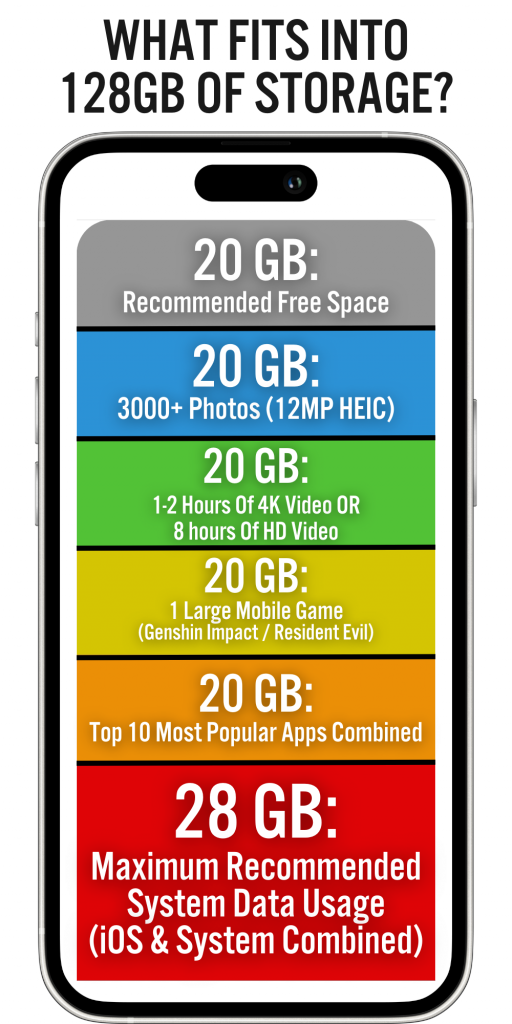
Is 128GB enough?
For most users, we think yes.
Once you take away the storage space you need to cover the bare minimum functions, you’re left with a comfortable 100GB. That’s enough for up to 30 hours of Full HD video, up to 22,000 photos, or 5 huge mobile games (we’re looking at you, Genshin Impact).
If you have a love for taking 4K videos with your iPhone, then you’ll only squeeze a few hours of footage onto your phone before needing to delete something, but serious camera lovers should consider a higher-spec iPhone anyway. Also, Apple offers affordable cloud storage options with iCloud+!
Did you know? Unlike many Android phones, iPhones don’t come with expandable storage – which means there is no option to add storage with a microSD card.
Processing Power: A16 Bionic Chip

3.46 GHz + 6GB RAM
The iPhone 14 Pro debuts the A16 Bionic chip, the same powerhouse processor found in the iPhone 15 and 15 Plus. With 16 AI cores and speeds that can rival some laptops, it’s built for serious performance. But, unless you’re a pro gamer or pushing your phone to its limits, you probably won’t notice a huge difference in day-to-day use compared to recent iPhones.
With 6GB of RAM, it’s more than enough for multitasking and smooth operation. Launched with iOS 16, the iPhone 14 Pro is set for around 5 years of software updates—meaning it could stay secure and speedy until 2027, if well cared for.
Attention Gamers!
For keen mobile gamers, or power users like me, we recommend the iPhone 15 Pro (or Pro Max). The A17 Pro chip in the iPhone 15 Pro even supports ray-traced graphics, and can play recent triple-A games!
All-Day Battery
The iPhone 14 Pro’s battery, when brand-spanking new out of the box, is advertised to last through up to 20 hours of constant YouTube videos.
To an Android user like me, these impressive battery life times feel like some kind of magic trick. The iPhone 14 has a smaller battery capacity than its main competitors, but still manages to outlast them in testing. Here’s how the iPhone 14 Pro’s battery stacks up against Apple’s other phones:
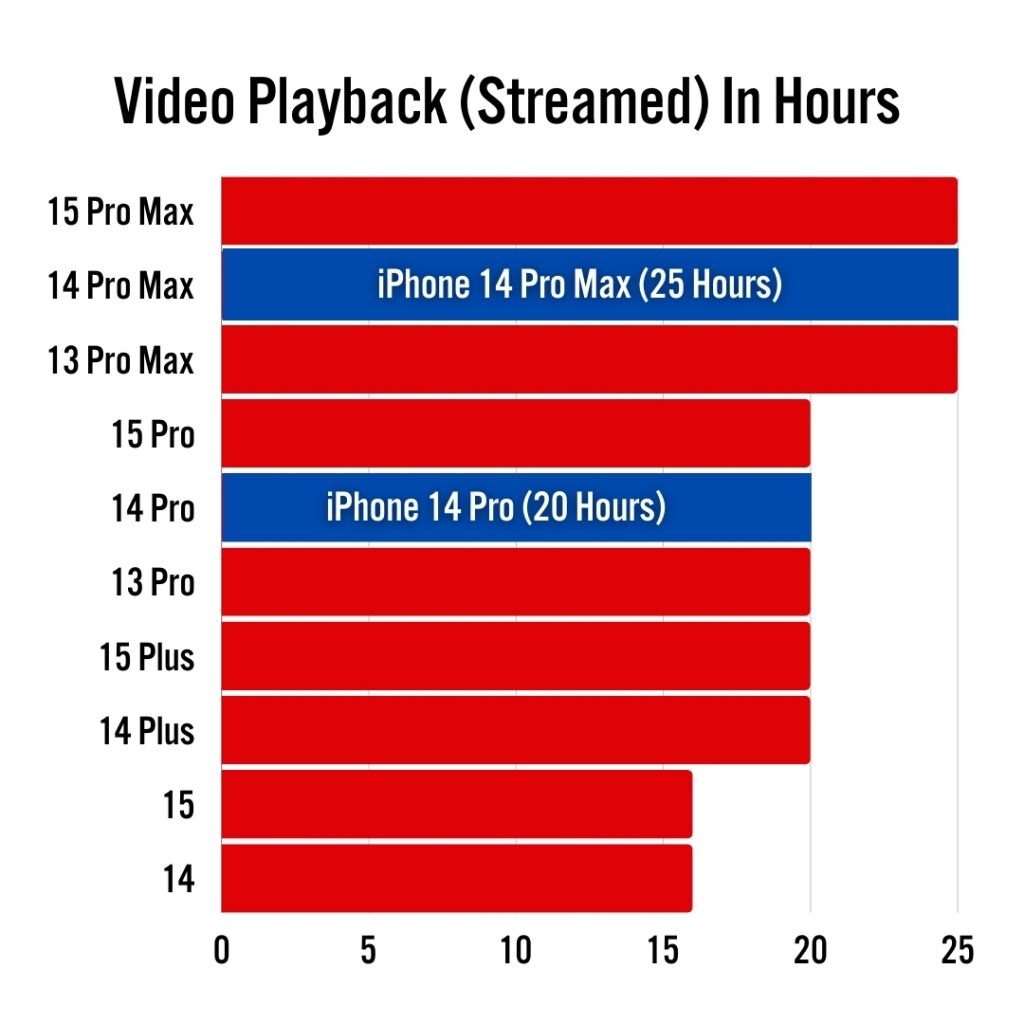
Fast Charging
The iPhone 14 Pro supports Apple’s 20W Fast-charging standard.
Wireless Charging
The iPhone 14 Pro is compatible with all Qi-certified wireless chargers (that’s all modern wireless phone chargers).
Smart Battery Optimisations
Thanks to Apple’s closed ecosystem, iPhones are typically able to get more battery life out of a smaller sized battery.
Battery Health
When you’re buying a refurbished phone, battery life can vary depending on the grade of the phone. At The Big Phone Store, our phones have a MINIMUM of 80% battery health* – enough for up to 12 hours of streaming video.
Don’t get caught out! Apple will give you a ‘battery health warning’ as soon as your iPhone’s battery health reaches 80%, but you don’t need to rush to replace your battery straight away. Just so long as you have enough charge to last you through the day, that’s what’s really important.
Camera
The iPhone 14 Pro and Pro Max brought major camera upgrades, including Apple’s Photonic Engine, an AI-driven image processing system that enhances all your photos. These models also debuted the 48MP pixel-binning sensor, delivering incredibly sharp images with improved low-light performance and reduced blur—perfect for capturing those tricky shots.
Both models also feature a Telephoto lens, ideal for outdoor and zoom photography. While the camera is a huge leap forward from previous iPhones, it does have some quirks. The AI processing can sometimes overdo facial touch-ups, giving faces an unnatural look—a flaw Apple has largely addressed in the iPhone 15.
iPhone 14 Camera Specs
Powered by: Photonic Engine (AI)
Main Lens (OIS, AF):
48MP, 26mm, ƒ/1.5
Wide Lens (120° FOV):
12MP, 13mm, ƒ/2.4
Selfie (TrueDepth):
12MP, ƒ/1.9
Display: Super Retina XDR
The iPhone 14 Pro uses the same Super Retina XDR display as the iPhone 14, and in fact every other iPhone since the 11 Pro.
Super Retina XDR displays like the one on the iPhone 14 Pro have a pixel density of about 460ppi (pixels per inch) – which for a phone held at a normal distance from your face, is a higher resolution than the human eye.
Here’s how far you need to zoom in before you can see the individual pixels on the screen:

Unlike the iPhone 11’s Liquid Retina screen, Super Retina is an LED display. LED displays (which include OLED and AMOLED) allow more contrast and brightness compared to LCD displays. Most flagship phones today use LED.
The screen refresh rate is 120hz, which is fast enough to be right at the limit of what humans can percieve. In other words, a faster display wouldn’t make any noticable improvement for most people.
Sustainability
Apple is committed to making its operations 100% carbon-neutral, and by 2030, they aim to offset the entire carbon footprint of their products. With each new iPhone, including the iPhone 14 Pro Max, Apple has increased the use of recycled materials, though some plastic remains in the packaging.
The iPhone 14 Pro Max has a carbon footprint of 70-125kg CO2e, the highest since the iPhone 11. For those prioritising sustainability, the iPhone 15 is a cleaner option, or better yet, switching to a refurbished phone dramatically cuts your carbon footprint.
In terms of energy use, iPhones shine with custom energy efficiency optimisations, allowing the iPhone 14 Pro to last longer on a single charge than many Android phones, even those with larger batteries. This makes it a more eco-friendly option for daily use.
“Apple’s commitment to carbon neutrality by 2030 looks achievable, but it doesn’t change the fact that buying a new phone always creates unnecessary emissions. The best way to avoid a large carbon footprint is always to buy a refurbished phone.” – Steve Athwal, Sustainability Expert
How does the iPhone 14 compare to Android?
Let’s compare the high-end models of 2022.
The iPhone 14 Pro Max made huge advances with its cameras over the 13 Pro, but Samsung’s camera improvements look like they’ve left Apple in the dust when it comes to resolution – on both the rear-facing and selfie cameras.
However, what the iPhone lacks in resolution it makes up in image processing, making these three phone’s cameras all valid options for the amateur photographer in you.
Ultimately this will be a close call for anybody, and if you’re already a lover of Samsung, Apple, or Google, you’re not likely to make the switch based on the small differences between these phones.
Samsung Galaxy S22 Ultra
Pros: 108MP primary camera, 8K video, 3x zoom lens, 40MP selfie camera, lighter, larger display
Cons: only 10MP selfie camera, more expensive
iPhone 14 Pro Max
48MP main camera, 12MP selfie camera, Best battery life
Works well with Apple ecosystem (AirDrop, AirTag, Apple Watch, FaceTime, App Store)
Google Pixel 7 Pro
Pros: 50MP primary camera, £200 cheaper, 48MP 5x Zoom camera
Cons: only 10.8MP selfie camera
The Boring Bit: Detailed Specifications
Below is a detailed list of the differences in specifications between the iPhone 14 Pro, and iPhone 14 Pro Max
